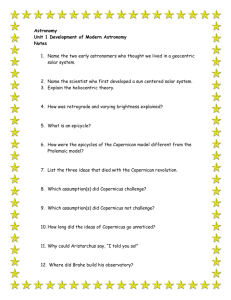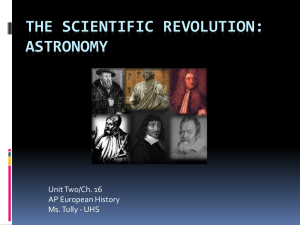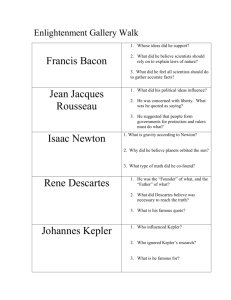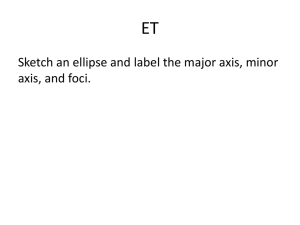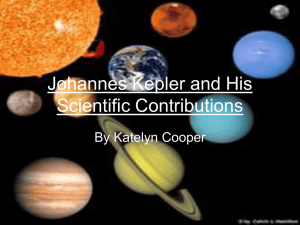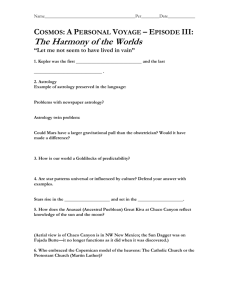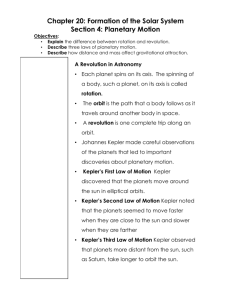Epicycles - Department of Physics & Astronomy
advertisement
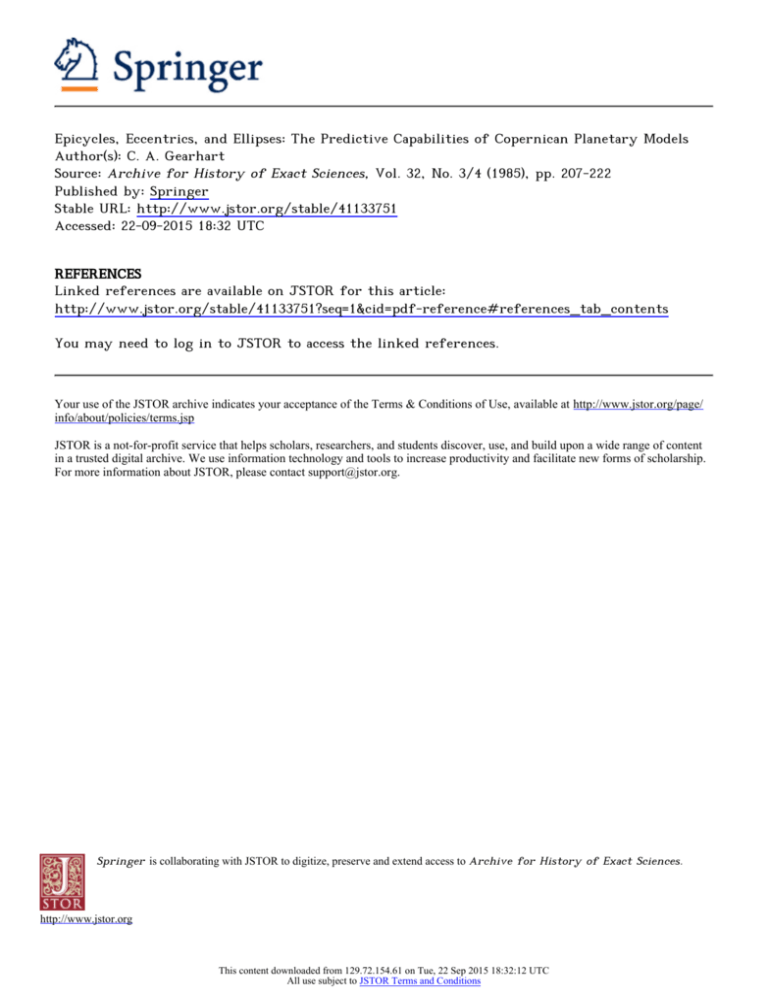
Epicycles, Eccentrics, and Ellipses: The Predictive Capabilities of Copernican Planetary Models
Author(s): C. A. Gearhart
Source: Archive for History of Exact Sciences, Vol. 32, No. 3/4 (1985), pp. 207-222
Published by: Springer
Stable URL: http://www.jstor.org/stable/41133751
Accessed: 22-09-2015 18:32 UTC
REFERENCES
Linked references are available on JSTOR for this article:
http://www.jstor.org/stable/41133751?seq=1&cid=pdf-reference#references_tab_contents
You may need to log in to JSTOR to access the linked references.
Your use of the JSTOR archive indicates your acceptance of the Terms & Conditions of Use, available at http://www.jstor.org/page/
info/about/policies/terms.jsp
JSTOR is a not-for-profit service that helps scholars, researchers, and students discover, use, and build upon a wide range of content
in a trusted digital archive. We use information technology and tools to increase productivity and facilitate new forms of scholarship.
For more information about JSTOR, please contact support@jstor.org.
Springer is collaborating with JSTOR to digitize, preserve and extend access to Archive for History of Exact Sciences.
http://www.jstor.org
This content downloaded from 129.72.154.61 on Tue, 22 Sep 2015 18:32:12 UTC
All use subject to JSTOR Terms and Conditions
andEllipses:
Epicycles,Eccentrics,
ThePredictive
Capabilitiesof
CopernicanPlanetaryModels
C. A. Gearhart
Communicated
by C. A. Wilson
Abstract
A theoretical
analysisof the potentialaccuracyof earlymodernplanetary
modelsemploying
of
compoundcirclessuggeststhatfairlysimpleextensions
thosemodelscan be sufficiently
accurateto meetthedemandsofTychoBrahe's
observations
in botheclipticlongitude
and latitude.Some of theseextensions,
suchas thesubstitution
ofthetruesunforthemeansun,had alreadybeentaken
involving
by Kepler beforehe abandonedcircularmodels.Otherextensions,
werewellwithinthe mathematical
one or two extraepicycles,
capabilitiesof
Hence neitherthe
astronomers.
and seventeenth-century
sixteenth-century
nor
errorsin planetary
failure
ofastronomers
beforeKepler to correct
positions
Kepler's decisionto abandoncircularmodelswas a consequenceof inherent
limitations
in thosemodels.
modelon evenso latea figure
The holdofthecircleas a predictive
planetary
to describethe orbit
as Kepler was strongindeed.Kepler's initialattempts
was mosttroublesome
of Mars,theplanetthatbecauseof itslargeeccentricity
involvedthe use of Ptolemy'sequant,in which
to pre-KEPLERian
astronomy,
theuniform
motionof theplaneton a circlewas measuredaboutan off-center
equantpoint(see Figure1a). Onlyafterthefailureof variouscircularequant
and latitudeof Mars withinthe
modelsto predictboththe eclipticlongitude
abandonthe
did Kepler reluctantly
accuracyof Tycho Brahe's observations
ledhimto theellipse.TnthissearchKepler
circleandadoptthepaththatfinally
butalso be (to
thatplanetary
modelsshouldnotonlypredictaccurately
insisted
did
not
use epicyclic
He
disliked
and
for
the
most
part
him)physically
plausible.
motion
on
an
for
because
he
see
no
basis
could
models,
epicycle.1
plausible
physical
1
Kepler, AstronomiaNova (1609), cap. 4. (All referencesto this work were taken
from Max Casper's German translation[Munich-Berlin:R.Oldenbourg, 1929].) See
also Alexandre Koyré, The AstronomicalRevolution(Ithaca: Cornell Univ. Press,
1973), p. 177.
This content downloaded from 129.72.154.61 on Tue, 22 Sep 2015 18:32:12 UTC
All use subject to JSTOR Terms and Conditions
C. A. Gearhart
208
A
a
A
At
j
b
Fig. 1. Copernican and equant models. The planet is located at P, and angle ASP is
the heliocentriclongitudein both. Figure 1a is the equant model. The sun S and the
equant point Q are both removed a distance e fromthe centerC of the deferent.The
angle AQP is the mean anomaly a. Figure 1 b is the Copernican model. The sun S is
removedSC = 3/2e fromthe centerof the deferent.Angle ACT is the mean anomaly a
that advances uniformlywith time. The epicyclehas a radius TP - 'e ox' which the
planet P rotates in a CCW sense, at a rate such that angle AiTP = 2a.
And he placed greatimportanceon a magneticanalogy,in whichhe imaginedthe
planets to be maintainedin theirorbitsby themagneticinfluenceof a rotating
sun.2
Neitherassumptionwas widelyshared,or widelyadopted. Most of Kepler's
immediatepredecessors,from Copernicus onward, used epicycles freelybut
foundthe equant physicallyimplausible,sinceit violatedtheprincipleof uniform
circularmotion.Nor did Kepler's magneticanalogyarouse any greatenthusiasm
in predictivepower
among his contemporaries.Even the enormousimprovement
affordedby the ellipse did not lead to the immediatewidespreadadoption of
Kepler's new astronomy;many astronomerspreferredto regardthe ellipse as
no more than an empiricallyaccurate descriptionof the orbit. The French astronomerBoulliau, for example, constructedelliptical orbits using circular
uniformcircularmotion.3Newton, too, who established
devices,thuspreserving
the theoreticalbasis of Kepler's laws, remarkedof Kepler that he "knew the
Orb ... to be oval and guest it to be Elliptical."4
Given this pre-NEWTONian
reluctanceto regardthe ellipticalpath as more
than an empiricaldescription,one may ask how inevitablewas the discoveryof
even this much by the early seventeenthcentury.Was it necessaryto turn to
2 Kepler's
developmentof this argumentis scatteredthroughoutthe Astronomia
Nova; fora good discussion,see Koyré, AstronomicalRevolution(note 1), pp. 197-214.
3 See Curtis A.
Wilson, "From Kepler's Laws, So-called, to UniversalGravitation:
Empirical Factors," Arch. Hist. Exact Sci. 6 (1969), 89-170, esp. p. 103 and HOflF.
4 H. W.
Turnbull, ed., The Correspondenceof Isaac Newton,vol.2, (Cambridge:
Cambridge UniversityPress, 1960), 436-37; quoted in Wilson, ibid.
This content downloaded from 129.72.154.61 on Tue, 22 Sep 2015 18:32:12 UTC
All use subject to JSTOR Terms and Conditions
and Ellipses
Epicycles,
Eccentrics,
209
elliptical(or perhaps oval) paths in order to satisfythe demands of Tycho
Brahe's observations?Or could a mathematically
capable astronomerin possession of Tycho Brahe's observations,but witha different
sense of what constitutedphysicalplausibility,have devised a satisfactory
planetarytheoryusing
only the uniformlyrotatingcircles of "traditional" astronomy? One cannot
predicthow astronomymighthave developedhad Kepler stopped shortof the
ellipse.But an analysisof thetheoreticalpossibilitiesof the traditional"circular"
and tellus something
astronomymightbothshed lighton Kepler's achievements
and seventeenth-century
about how sixteenth-century
astronomersthoughtabout
planetarymodels and theirrelationto observations.
It has long been known that the planetarymodels of Ptolemy and Copernicus for, say, the outer planets are verysimilarboth mathematicallyand in
mathematicianA. F.
predictiveaccuracy,5a resultthat the nineteenth-century
Möbius tracedto the factthatboth constructions
approximatean ellipseto first
Fred Hoyle has
the Britishastrophysicist
More recently,
orderin eccentricity.6
the latterresultand expressedit in an elegantformulation
rediscovered
involving
for
to
search
Hoyle's
In
I
shall
use
what
variables.7
follows,
analysis
complex
more accurate circularmodels. Hoyle begins with a standard result: For an
ellipticalorbitobeyingKepler's second law, the orbitallongitude0 and radius r
as functionsof mean anomalyoc(the angle, measuredfromperihelion,that adwithtime) are givenby the followingseriesexpansionsin the
vances uniformly
eccentricity:8
0 = oc+ 2e sinoc+ |- e2 sin2oc-f . . .,
(1)
e1
r
- = l - e cos oc- - (cos 2oc- 1) -f . . . ,
2
a
(2)
For convenience,I shall
wherea is the semi-majoraxis and e the eccentricity.
choose a = 1 below. Hoyle's techniqueinvolvesusing these expressionsfor r
and 0 to definethe complex variable
z = rexp(/0),
(3)
the positionof a planetin the complexplane. Hoyle calculated
whichrepresents
z onlyto thefirstorderin e. If we extendthiscalculationby substituting
Equations
5 See forexampleNoel M. Swerdlow, "The Derivation
and FirstDraftof CoperwithCommentary,"
nicus'PlanetaryTheory:A Translationof the Commentariolus
469.
117
Proc. Am. Phil.Soc.
(1973),423-512,esp. p.
6 August FerdinandMöbius,Gesammelte
Werke,vol. IV (Leipzig,1887),p. 77ff.
of Kepler's Astronomia
to the Germantranslation
Max Casper, in his Introduction
Nova (note 1), arrivesat a similarresult.
7 Fred Hoyle, Nicolaus Copernicus:An Essay on his Lije and Work (New York:
Harper and Row, 1973), esp. Chap. 4.
0 See tor example t. K. MOULTON,An introductionto celestial Mecnanics ^rsew
York: Macmillan, 1935), p. 171.
This content downloaded from 129.72.154.61 on Tue, 22 Sep 2015 18:32:12 UTC
All use subject to JSTOR Terms and Conditions
CA. Gearhart
210
termsto ordere2, we obtain
(1) and (2) intoEquation(3), retaining
z = - -| e + exp(ia) + -j e exp(2io¿)
e2
- - exp(ia) + }e2 exp(3/a)+ e2 exp(-za).
-g-
(4)
If theoriginof thecomplexplanerepresents
thesun,thefirstoftheordere
a negativedisplacement
termsin Equation(4) represents
of 3/2e on the real
eccentric
the
the
in
of
sun
Copernicus'
model.The second
axis,
displacement
a deferent
termrepresents
circleofunitradius,and thethirdan epicycle
ofradius
on
and rotating
at twicetherateof thedeferent
e/2mounted thedeferent
(as
measured
froma lineparallelto thelineofapsides).Themodeldescribed
bythese
firstthreeterms,
and shownin Fig. 1b, is essentially
theconstruction
of Copernicus. I have,however,
followedthemodernconvention
ofmeasuring
longitude
fromperihelion,
andhavealsodeparted
fromCopernicus'procedure
bymeasuring
all anglesfromthelineofapsides(lineASC inFig. 1). Hoyle hasalso shownthat
theordere termsin Equation(4) can be rewritten
ze = (1 + e cosoc)exp(ia) - 2e9
(5)
an equationthatto ordere describes
theequantconstruction
usedbyPtolemyand, in his initialefforts,
by Kepler.
A;
A3
A2
A«
i
Fig. 2. Order e2 model of Equation (4) for a = 30°. The mean anomaly a is angle
AiCT, similarto Figure 1 b. The largest("Copernican") epicyclehas a radius TR = ' e,
and rotates CCW so that angle A2TR = 2a; the next largesthas a radius RV = y*2
and rotates CCW, so that angle A3RV = 3a; and the smallest epicycle has a radius
VP = y e2 and rotatesCW so thatangle A4VP = -«. The planet is at P, the sun at S,
and the angle ASP is the heliocentriclongitude.The figureis not to scale.
This content downloaded from 129.72.154.61 on Tue, 22 Sep 2015 18:32:12 UTC
All use subject to JSTOR Terms and Conditions
and Ellipses
Eccentrics,
Epicycles,
211
model.
The order e2 termscan also be representedby a deferent-epicycle
as a shorteningof
The term - e2j2 exp (itx) is perhapsmost readilyinterpreted
the radius of the deferent,althoughit could also be describedby an epicycle.
e2 exp (3¿%) can be representedby an epicycle of radius -jj-e2, roThe term-jjtatingin the same sense as the deferentbut threetimesas fast. Similarly,the
term-§-e2 exp (-/a) can be representedby an epicycleof radius -g-e2 rotating
at the same rate as the deferentbut in the oppositesense. This model,shown in
Fig. 2 fora meananomalya of 30°, shouldapproximatean ellipseto second order
in eccentricity.
A model verynearlyas accuratecould be based on the Ptolemaic
in whichthe two ordere2 epicyclesare mountedon a deferentof
construction,
radius 1 - e2/2. In this model, the centerof the deferentis half-waybetween
the sun and the equant point,about whichthe mean anomaly is measured.
Either of these models should representa considerable improvementin
accuracy.The pointis not thatit is in principlepossibleto approximatean ellipse
to any desireddegree of accuracyby adding additional epicycles,in the spirit
or earlyseventeenth-century
of a Fourier series.Rather,it is to ask ifa sixteentha
astronomermightplausiblyhave come upon constructioninvolvingone or two
extra epicycles- one that would have been accurate to withinthe 3' or 4' of
arc demanded by Tycho Brahe's observations.Or did inherentlimitationsin
model make a break with compound
any reasonablysimple deferent-epicycle
circlesinevitableby the earlyseventeenth
centuryif the demandsof those obserwere possible,and
vationswereto be met? I shall argue thatsuch constructions
be answered:
must
Two
not
was
a
that
break
hence
compelled.
questions,then,
and
how
e2
is
the
order
construction,
plausibleis it,mathepreciselyhow accurate
asor
that
a
sixteenthearly seventeenth-century
maticallyand calculationally,
tronomermighthave discoveredit or some suitablevariant.
Estimatingthe accuracyof a particularplanetarymodel is not altogetheran
easy task. One common approach for the outer planetsis to calculate the geocentriclongitudeat opposition,when, because the sun, earth, and planet all
lie nearlyalong a straightline,the geocentriclongitudeis equivalentto the heliocentriclongitudealong the ecliptic.Observationsof opposition were essential
to the constructionof planetarymodels for both Copernicus and Ptolemy,
because such observationspermitthe analysis of the motion of the planet independentof the motion of the earth; in the language used by early modern
astronomers,
theypermittheseparateanalysisof thefirstand second inequalities.
Thus it was naturalto regardpredictionsof thepositionof a planetat opposition
as a testof the theory.Using thiscriterion,the models of both Copernicus and
Ptolemy were in principlecapable of predictingoppositions(and hence heliocentriclongitudes)to within10' or 12' of arc, even for the troublesomeMars.9
The accuracyof these predictionscould, however,be degraded in a variety
of ways. For example,the observationalbase used to determinethe parameters
9 See below. See also D. T. Whiteside, "Keplerian PlanetaryEggs, Laid and Unlaid, 1600-1605," J. Hist. Astron.5 (1974), 1-21 ; and Stanley E. Babb, Jr.,"Accuracy
of PlanetaryTheories, particularlyfor Mars," Isis 68 (1977), 426-434.
This content downloaded from 129.72.154.61 on Tue, 22 Sep 2015 18:32:12 UTC
All use subject to JSTOR Terms and Conditions
212
CA. Gearhart
observations
modelswas bothsparseand erratic.Some planetary
of planetary
beforeTycho Brahe's, mostnotablythoseof thefifteenth-century
Nuremburg
Bernard Walther, wereapparently
accurateto within5', although
astronomer
forsystematic
correction
error
showinga randomscatterof 10', and requiring
starswithrespectto whichtheobservations
were
in thepositionsofthereference
madeby Copernicushimself,
and used bothby
made.10Yet the observations
himand laterby ErasmusReinholdto determine
theparameters
of theCoperoffby 20' to 30', and in thecase of Mars,by as
nicanmodels,weretypically
muchas 2o.11
Even moreseriousare theadditionalerrorsinvolvedin calculating
thegeoand latitudesof the planets,whichdependnot onlyon the
centriclongitudes
but also on the radiiof the orbits
heliocentric
longitudes
-quantitiesthatare
construcagainaccurateonlyto ordere in boththePtolemaicand Copernican
and
is
tions.Anda concernforgeocentric
latitude
essential
to
an acculongitude
be
ratereformulation
of planetary
it
Kepler's
or
the
one
theory,
hypothetical
If
an
below.
astronomer
were
concerned
with
heliocentric
presented
only
longitude,Kepler's vicarioushypothesis
(an equanttheoryin whichthe distances
to thesunandtheearthareunequal)approximates
fromthecenterofthedeferent
theheliocentric
of Marsto within2' or so. Onlywhenone insiststhat
longitude
a theorypredictgeocentric
do all first-order
in the
theories
positionsaccurately
breakdownwhencomparedto Brahe's observations.
eccentricity
In calculatinggeocentric
positions,one mustof courseuse a sufficiently
accuratesolartheory(thatis, theory
forthemotionof theearth-or sun).And
solartheoriesbeforeKepler wereunnecessarily
degradedin twoways,theuse
ofthemeansuninsteadofthetruesun,and theuse ofa simpleeccentric
model
forthesun.
BeforeKepler, astronomers
used themean sun insteadof thetruesun to
thetimeof opposition.The term"meansun" refers
determine
to themeanor
averagepositionof thesun,and is calculatedfromthemeanmotionof thesun
Copernicussimply
(or earth).Its use goesbackto Ptolemy,whosesolartheory
transferred
to a heliocentric
context.Bothused a simpleeccentric
model;that
ofCopernicuscanbe described
byFigure1b, butwiththesmallepicycle
removed,
so thattheearthis at pointT. The truesun,then,is at S, andthemeansunat C,
thecenteroftheearth'sdeferent
and thepointaboutwhichthemeananomalyoc
is measured.
The eccentric
distanceSC is 2e in thismodel.(Copernicusthought
thedistanceSC variedslightly
bothin magnitude
anddirection
overtimeson the
orderof thousandsof years,so hisfullsolartheoryis rathermorecomplicated
thantheforegoing
suggests.)Copernicusrefersthe orbitsof the otherplanets
10 See two
papers by Richard L. Kremer, "Bernard Walther's Astronomical
Observations,"J. Hist. Astron. 11 (1980), 174-191; and "The Use of BernardWalther's
AstronomicalObservations in Early Modern Astronomy,"J. Hist. Astron. 12 (1981),
125-132.
11 Owen
Gingerich, "Was Ptolemya Fraud?" Quart. J. Roy Astron.Soc. 21 (1980)
253-266, esp. p. 258; and Owen Gingerich, "Commentary: Remarks on Copernicus'
Observations," in Robert S. Westman, ed., The CopernicanAchievement(Berkeley:
Univ. of California Press, 1975), pp. 99-107.
This content downloaded from 129.72.154.61 on Tue, 22 Sep 2015 18:32:12 UTC
All use subject to JSTOR Terms and Conditions
and Ellipses
Eccentrics,
Epicycles,
213
to themean sun,so thatin thecontextof Equation (4), theoriginwould be taken
to be the mean, and not the true,sun. And like Ptolemy,he definesopposition
as the timeat whichthe planet and the mean sun are 180° apart.12
Kepler's firststepin his attackon Mars, takenwell beforehe had abandoned
the circle,was to realize that this use of the mean sun underminesthe whole
pointof the use of oppositionsin separatingthemotionsof the planetsfromthat
of theearth;and in his firstuse of Tycho Brahe's observations,he showedthat
the use of the mean sun involvederrorsforMars in heliocentriclongitudeup to
Table 1. PredictiveAccuracyof PlanetaryModels forthe Orbit of Mars
Maximum MaximumGeocentric
Error(Equant
Errorin
Heliocentric Solar Theory)
Lat.
Longitude Long.
Planetary
Modelfor
Mars
MaximumGeocentric
Error(Simple EccentrieSolar Theory)
Lat.
Long.
Equant
(Fig. la)
9.0'
36.0'
1.6'
Io 16'
11'
Copernican
(Fig. lb)
11.0'
51.0'
2.4'
1°16'
11'
1°16'
11'
Kepler's Vicarious
Hypothesis
2.5'
2° 10'
Copernicanwith
O(e2) TermsFig. 2)
2.0'
5.4'
0.3'
ModifiedO(e2) Model
of Fig. 3 (deferent
radius = 1, epicycle
radius = 0.25 e2
2.5'
33.0'
3.7'
ModifiedO(e2) Model
of Fig. 3 (deferent
radius = 1 - e2/2,
epicycleradius =
0.25 e2)
0.5'
13.2'
2.6'
ModifiedO(e2) Model
of Fig. 3 (deferent
radius = 1 - e2/2,
epicycleradius = 0.3 e2)
1.7'
10.8'
2.1'
26'
Parameters: The AmericanEphemerisand Nautical Almanac, 1977 (U.S. Government
PrintingOffice,Washington,1976), p. 216.
12 Copernicus, De Rev., Book 5, chap. 4. See also O. Neugebauer, A Historyof
AncientMathematicalAstronomy(New York: SpringerVerlag, 1975), part 1, p. 58;
Swerdlow, "Derivation and First Draft of Copernicus' PlanetaryTheory," (note 5);
and J. L. E. Dreyer, TychoBrake (London: Black, 1890; reprintedNew York: Dover,
1963), p. 346 (Dover ed.).
This content downloaded from 129.72.154.61 on Tue, 22 Sep 2015 18:32:12 UTC
All use subject to JSTOR Terms and Conditions
C. A. Gearhart
214
5', and in geocentriclongitudeup to Io 3'.13 Withoutthisstep,any reformation
of planetarytheorymighthope to do moderatelywell in heliocentriclongitude,
but could not hope to predictgeocentricpositionaccurately.
Moreover, as Kepler realized somewhatlater, the simple eccentricsolar
theoryis itselfinadequate, and so unnecessarilydegrades predictionsof geocentricposition.On the one hand, an eccentricity
2e yieldsquite tolerableerrors
of about 40" in heliocentriclongitude,but at the cost of errorsin the radii of
the earth'sorbitthat lead to unacceptablegeocentricpositions.(See Table 1 for
several comparisonsof this solar theoryto one that uses an equant, or alternatively,the Copernicanconstructionof Figure 1b.) On the otherhand, the core in a simpleeccentricmodel greatlyreduceserrorsin the radii,
recteccentricity
but the errorin heliocentriclongitudeincreasesto nearlyIo; such errorscan lead
to errorsup to twice as large in geocentriclongitudefor Mars.14
There are at least two other ways in which models were unnecessarilydegraded.Errorsin predictinggeocentriclatitudearise fromthe highlycomplicated
constructionsneeded by both Ptolemy and Copernicus because the plane of
the Ptolemaicdeferentpasses throughthe earth,and theplane of the Copernican
orbit passes throughthe mean sun instead of the true sun. In Ptolemy's case,
these errorswere seeminglyas large as 20.15This difficulty
was one of the first
to be resolvedby Kepler, who showed for the firsttimethat the planetsmove
in planes that pass throughthe true sun.16
Finally, the calculation of planetarypositions from firstprinciplesusing
eitherPtolemaic or Copernican models was sufficiently
complicatedthat planewere
calculated
tables
derived
fromthemodels.These
tarypositions
usually
using
tables introducedadditional errors,small for most planets,but substantial(as
large as half a degreefor the Copernicantables) for Mars.17
Thus, it is hardly surprisingthat both the AlphonsineTables (Ptolemaic)
and thePrutenicTables (Copernican)showerrorsin theirpredictionsof geocentric
13
Kepler, AstronomiaNova (note 1), cap. 6. See also J. L. E. Dreyer, A History
of Astronomy
fromThaïes to Kepler(Cambridge: CambridgeUniv. Press, 1906; reprinted
New York: Dover, 1953), pp. 343-344 (Dover edition); and fora verycompleteaccount
of Kepler's procedure,Robert Small, An Accountof the AstronomicalDiscoveriesof
Kepler (1804; reprintedMadison: Univ. of WisconsinPress, 1963), pp. 148-157. But see
also J. B. Delambre, Histoirede VAstronomie
Moderne(Paris, 1821; reprintedNew York:
Johnson,1969), vol. 1, p. 569if. for a criticismof Kepler's approach.
14 If 0 and A are the heliocentric
longitudesof Mars and the earth respectively,
f the geocentriclongitudeof Mars and q the ratio of the radius of the earth's orbit to
that of Mars, it can be shown that
H
= [q cos(A - f)] [o cos(A - f) + costf - 0)]-1 .
For Mars, df/dA^ 2. The partial derivativesare used to emphasize that errors in S
due to errorsin o are not considered here.
15
Neugebauer, History (note 12), part 1, p. 146.
16
Kepler, AstronomiaNova (note 1), cap. 6. See also Koyre, AstronomicalRevolution (note 1), p. 168; and Dreyer, Astronomy
from Thaïes to Kepler (note 13), p. 389.
11
Babb, "Accuracy of PlanetaryTheories" (note 9), p. 429 ft.
This content downloaded from 129.72.154.61 on Tue, 22 Sep 2015 18:32:12 UTC
All use subject to JSTOR Terms and Conditions
and Ellipses
Eccentrics,
Epicycles,
215
18
longitudeas largeas severaldegrees. Since the moon subtendsan angle of only
30', it is apparentthatsuch errorsare enormous,easilydetectableby the crudest
unaided eye observations.That errorsof this magnitudedrew so littleattention
is somewhatsurprising,at least froma modernpoint of view. Copernicus, for
example,nowherementionssuch discrepanciesas a motiveforhis reformulation
of astronomy,even thoughhe was apparentlyaware of them.19
Whatis less apparentis how muchthispredictiveerroris due to theinaccurate
parametersand calculationalproceduresdescribedabove, and how much is truly
intrinsic
to the models.In approachingthisquestion,I shall considerthe matheasmatical and calculational position of a hypotheticallate-sixteenth-century
describedherebut who was
tronomerwho had overcomemanyof the difficulties
committedto a traditionalmodel usingcompound circles.Such an
nevertheless
astronomerwould have had access to the observationsof Tycho Brahe, which
Kepler believedto be accurate to withinperhaps3' of arc,20and would have
takenthechallengeposed by thoseobservationsseriously.And, also like Kepler,
this astronomerwould have substitutedthe true sun for the mean sun in calculatingoppositions;would have vastlyimprovedand simplifiedthe calculation
of geocentriclatitudeby insistingthat the planes of the planetaryorbitspass
throughthe true sun; and finally,would have realized that a simple eccentric
model will not representthe earth's (or sun's) orbit with sufficient
accuracy.
of the earth'sorbitis, however,small enoughthat eitherof the
The eccentricity
theoriesin Figure 1, will suffice;furthermodificationsare required
first-order
for
only
planets,like Mars, withlargereccentricities.
Table 1 presentsthe discrepanciesbetweenplanetaryheliocentricand geocentricpositionsfor Mars calculated for various models, and those predicted
froman ellipse.(The actual positionsof Mars differfromthose calculatedfrom
an ellipseby less than I'.21) The parametersused are modernones, taken from
The AmericanEphemerisand NauticalAlmanac,1977. In all cases (exceptingonly
Kepler's vicarious hypothesis,whichis includedin the table for comparison),
these models predictlatitudesthat differfromthose predictedusing an ellipse
by no morethan 2' or 3'. The geocentricpredictionsof thesemodels are indeed
less accuratethan the correspondingheliocentricpredictions,but the increased
errorshows up primarilyin the predictionof geocentriclongitude.
In calculatinggeocentricpositions for the various models, I have usually
used an equant to findthe positionof the earth. And ratherthan attemptto
18 Owen
Gingerich, "Commentary," (note 11), p. 106; and also Owen Gingerich,
"The Role of Erasmus Reinhold and the Prutenic Tables in the Dissemination of Copernican Astronomy," in Studia Copernicana VI (Wroclow, 1973), esp. p. 54.
iy
Gingerich, "Commentary, (note 11), pp. 1U3-1U7.
zu It is difficult to
get a clear picture ot precisely how accurate kepler tnougnt
Tycho's observations; but see Kepler, Astronomia Nova (note 1), cap. 10; Small,
Account (note 13), p. 325; Whiteside, "Keplerian Planetary Eggs" (note 9), p. 18;
Owen Gingerich, "Kepler's Treatment of Redundant Observations," in Internationales
Kepler Symposium, ¡Veil der Stadt 1971 (Hildesheim, 1973), 307-318, esp. p. 311; and
Walter G. Wesley, "The Accuracy of Tycho Brahe's Instruments," J. Hist. Astron. 9
(1978), 42-53.
21
Babb, "Accuracy of Planetary Theories" (note 9), p. 432.
This content downloaded from 129.72.154.61 on Tue, 22 Sep 2015 18:32:12 UTC
All use subject to JSTOR Terms and Conditions
C. A. Gearhart
216
constructan ephemeris,I have calculated geocentricpositionsby firstchoosing
a heliocentricpositionfor Mars, and thencalculatingthe geocentricpositionas
seen froma numberof different
pointsalong the orbitof the earth.This method
has a substantialcalculationaladvantageover the constructionof an ephemeris;
one can findboth maximumand typicalerrorsfor a given model much more
quicklyand directly.The method has the disadvantageof neglectingerrorsin
geocentricposition occasioned by errorsin the earth's heliocentriclongitude.
of the earth,however,sucherrorsforeitheran equant
Giventhe small eccentricity
or a Copernican model are never greaterthan 15", and translateinto errors
no greaterthan 30" in geocentricposition.22
Table 1 contains a number of interestingfeatures.The heliocentricerror,
as has already been suggested,gives a verymisleadingnotion of the accuracy
of the model. Both the Copernicanand the equant modelsshow maximumheliocentricerrorsof about 10', but geocentricerrorsup to about 50', even usingan
equant model forthe earth.The largergeocentricerrorforthe Copernicanmodel
derivesfromits substantiallylargererrorsin radius. (Most of the radial erroris
attributableto Mars; onlya slightimprovement
in geocentricpositionis obtained
an
an
rather
than
to
by using
ellipse
equant calculate the orbitalradius of the
earth.)
By contrast,the order e2 theoryof Equation (4) and Figure2 predictsheliocentriclongitudesto withinabout 2' and geocentriclongitudesto withinabout
5'. (Both numbersrepresentmaximumerrors;typicalerrorsare smaller.)Thus
the extra epicyclesand shorterdeferentradius improveboth the heliocentric
longitudesand radii substantially.Like the ellipse, then,this model represents
the observationsof Brahe verywell,not only at oppositionbut also at arbitrary
positions.Note, however,the importanceof an accurate solar theory;using a
simpleeccentricto calculate the radii of the earth's orbitsubstantiallydegrades
both order e and order e2 theories.
Sixteenth-and early seventeenth-century
astronomers,to be sure, had at
their disposal neitherthe complex variable methods used above, nor, before
Kepler, the knowledgethat the trueorbitwas an ellipse.How likelyis it, then,
that a mathematicallycompetentastronomerof that period mighthave come
across the order e2 constructionor some suitablevariant?
A comparisonof the predictionsof eitheran equant or a Copernicanmodel
to an ellipse (or, more to the point, to observations)shows (measuringheliocentriclongitudefromperihelion)that the models lag behind the observations
in the firstand thirdquadrantsand runahead of themin the second and fourth.
And -less obvious, but known to Kepler, and hence extractablefromBrahe's
- the radii of both models are too
observations23
large everywherebut along
the line of apsides,and are worstat the quadrants(90° and 270°). Both problems
are slightlymore severein a Copernicanthan in an equant model.
An epicyclerotatingthreetimes as fast as the mean anomaly (with respect
to the line of apsides), and in the same sense,would tend to correctat least the
22 See note 14.
23
Dreyer, Astronomy
from Thaïes to Kepler (note 13), p. 389.
This content downloaded from 129.72.154.61 on Tue, 22 Sep 2015 18:32:12 UTC
All use subject to JSTOR Terms and Conditions
andEllipses
Eccentrics,
Epicycles,
217
firstdeficiency,
An appropriate
radius
as Figure3 demonstrates
qualitatively.
theordere2 termsof Equation(4)
forthisepicyclecan be foundby reducing
to theform
e2
e2
zci = - (' cos 2oc- 1) exp(ia) + - exp(3/a).
(6)
A
by Equation(6). TR = ' e as in Figure2. RP = ' e2 and
Fig.3. Modelsuggested
CCWat a rate3*.
advances
ofradiuse2/4thatrotates
an epicycle
Thesecondtermin Equation(6) represents
of
and that,as a comparison
as required
at threetimestherateofthedeferent
of
bothordere2 epicycles Equarepresents
Equations(4) and (6) willconfirm,
tion(4) exactlyat theoctants.The first-order
Copernicanmodelof Figure1b
an ellipsewitha
withthissingleadditionalepicycle(Figure3) approximates
of 2' 30", and in geocentric
errorin heliocentric
maximum
longitude
longitude
of this
of about30', as can be seenfromTable 1. The heliocentric
longitudes
and lead themin
in thefirstand secondquadrants,
modellag theobservations
as longas theradiusoftheepicycleis about e2/4,a value
thethirdand fourth,
thoseat
error.Andall oftheradii,including
thattendsto minimize
heliocentric
theapsides,are too large.
As the preceding
analysismightsuggest,thismodelcan be improvedstill
Suchan improvement
further
theradiusofthedeferent.
suggest
might
byreducing
actual
radiiof theorbit.Astronomers
withthe
of course,by comparison
itself,
butthereis anotherpathto
suchcalculations,
beforeKepler did notundertake
This content downloaded from 129.72.154.61 on Tue, 22 Sep 2015 18:32:12 UTC
All use subject to JSTOR Terms and Conditions
218
C. A. Gearhart
the same conclusion: an astronomerwho had introducedthe additional small
epicycleof Figure3, witha radius of about e2/4chosen to minimizeheliocentric
errordescribedin the last paraerror,would findthatthe patternof heliocentric
as is apparent
graphcan be reducedby an appropriateshrinkingof the deferent,
fromFigure4.24 This model (Figure 3), withthe same two epicyclesbut witha
deferentreduced to 1 - e2/2,has a maximumerror in heliocentriclongitude
- and a maximum
of less than 30" - betterthan Kepler's vicarious hypothesis
errorin geocentriclongitudeof about 13' (see Table 1). The maximumerrorin
latitudeis about 2.6'. These are maximumerrors,and occuronlynearoppositions
for which Mars is close to perihelion.More typicalerrorsare in the range 4'
to 8' in longitude,and 2' or less in latitude.
A
i f ''
)
' V„
S^w
Fig. 4. Shorteningthe deferentCP increasesthe longitude(angle ASP) in the firsttwo
quadrants,and retardsit in the last two. Adding the epicycles(Figures 3) does not alter
thiseffect.
Othercombinationsof epicycleand deferentradius in Figure3 are of course
possible. For example,if the radius of the deferentis 1 - e2¡2 and the radius
of the smallerepicycleis 0.3 e2, the maximumerrorsin heliocentriclongitude,
geocentriclongitude,and geocentriclatitude are respectively1.7', 11', and 2'.
(Even though the geocentricpredictionsof this model are slightlybetter,the
epicycleis large enough that it does not minimizeheliocentricerror,and shows
the heliocentricerror patterndescribed above for an epicycle radius of e2/4
onlyif the shorterdeferentradiusis not employed.)Or, to giveanotherexample,
a closerinspectionof the orbitradii in the model discussedabove could conceiv24 Kepler himselfused
reasoningof thissort. See Small, Account(note 13), p. 276.
This content downloaded from 129.72.154.61 on Tue, 22 Sep 2015 18:32:12 UTC
All use subject to JSTOR Terms and Conditions
and Ellipses
Eccentrics,
Epicycles,
219
radius; note fromEquation
ably lead to a librating(thatis, oscillating)deferent
if
that
(6)
e1 e1
^def= 1 -y + -JCOS2*
(7)
the fullordere2 model is restored.Other,similarvariationson this thememay
easily be imagined.25
Thus, an astronomerwho in seeking improved predictiveaccuracy had
realizedthe usefulnessof a small epicyclerotatingat a rate 3« would have had
at his commanda varietyof possible models, all of whichwould have yielded
heliocentriclongitudesand geocentriclatitudes well within the accuracy of
Tycho Brahe's observations.Even the errorsin geocentriclongitude- IT to
33' in the two epicycle-modelsof Figure 3, describedabove-might well have
seemedacceptable.Kepler, in his analysisof the oval theorythat precededhis
discoveryof the ellipse,rejectedthat hypothesisin part because it led to errors
in geocentriclongitudeas large as 20'.26 But his RudolphineTables, based on
the ellipse,are accurate only to withinabout 10' for Mars.27 One can easily
imaginean astronomerbeing so delightedwith accurateheliocentriclongitudes
and geocentriclatitudesthat errorsin geocentriclongitudeof 11' to 33' might
not have seemedtoo serious,evenhad he realizedtheirmagnitude.And he might
25 A
comparisonof the resultsof Table 1 with the recentresultsof Babb (note 9)
fora numberof reasons. Babb forthe most part cites average
but difficult
is interesting,
(rms) errors,neglects calculations of latitude, and determinesparameters not from
theoreticalmodels (e.g., thatof Equation (4) and Figure 2) but fromthe resultsof leastsquares fits.He does not state what solar theoryhe used for geocentriccalculations,
accurate to suggestthat somethingbetterthan a simple
but his resultsare sufficiently
eccentricwas employed.It is possible to make a rough comparison of maximumgeocentricerrorsfor Mars based on his Figure 1 ; his maximumerrorforan equant model
is consistentwithmine(roughly20'), butthatfora Copernicanmodel is smallerthanmine
(about 20' comparedto my51'). The discrepancyprobablyresultsin part fromdifferent
parameters:I used those of Equation (4), and he used parametersderivedfroma leastsquares fit;and in additionhe seems to have calculated an ephemerisratherthan seeking
I doubt that thereis any conflictbetweenour
maximumerrors.Given thesedifferences,
results,but a detailed comparison is difficult.
Babb does find some modified order e models that yield reasonable geocentric
longitudes,witha maximumerrorof about 10' (he does not calculate latitudes). For
example,he almost duplicatesthe resultsof Kepler's vicarioushypothesisforthe calculation of heliocentricpositions(i.e., oppositions).The consequencesforgeocentricposition,usingthe same parameters,are shown in myTable 1. Hence he requiresa separate
numericalparameters,in orderto findreasonable geocentric
fit,thatyieldsverydifferent
theapproach is unlikelyto be calculationally
is interesting,
the
result
longitudes.Although
Kepler's calculations for the (helioof
electronic
the
use
without
computers;
practical
centric)vicarioushypothesiswerebad enough! By contrast,theordere2 models described
in this paper use the same parametersfor both heliocentricand geocentricposition.
26
Small, Account(note 13), p. 276.
27 Owen
Gingerich, Johannes Kepler, in Dictionary oj scientificBiography,
vol. VII (New York: Charles Scribner'sSons, 1973), p. 305.
This content downloaded from 129.72.154.61 on Tue, 22 Sep 2015 18:32:12 UTC
All use subject to JSTOR Terms and Conditions
220
C. A. Gearhart
not have, at least initially;it mightwell have been necessaryto extendephemeris
calculationsof geocentriclongitudeover some yearsbeforethe maximumerrors
inherentin a particularmodel emerged.Even if theseerrorshad been recognized
of thismodel overeitherfirst-order
and thoughtsignificant,
thesuperiority
theory
to continuealong the same lines
could easily have providedthe encouragement
in search of a still bettertheory.
GN'
'
^ _____
_______^
/ ''X
SB is perpenFig. 5. GS, RH, and PK are all parallelto CT, theradiusofthedeferent.
dicularto CT. AngleGSP = angleSPB = ô. The sunis at S, theplanetat P, and angle
ASP is theheliocentric
longitude.
The geometricanalysisof theordere2 theorieswould have been quitestraightforwardfor a sixteenth-or early seventeenth-century
astronomer.(Indeed, the
analysis is rathersimplerthan that in the very complicatedmodels used for
Mercuryin both the Copernican and Ptolemaic systems.)Figure 5 shows the
two-epicyclemodel of Figure 3 as such an astronomermighthave analyzed it.
To calculate the longitudeof the planet P, one firstcalculates the equation of
center ô, which an elementaryif tedious analysis of Figure 5 shows to be
I2č
sina
' + -cosai
=
ô
tan
.
72
R - e cos oc+ - cos 2oc
4
(8)
Here R is the radius of the deferent(either1 or 1 - e2/2) in this model), and
(x and e are the mean anomalyand eccentricity
as before.The longirespectively,
This content downloaded from 129.72.154.61 on Tue, 22 Sep 2015 18:32:12 UTC
All use subject to JSTOR Terms and Conditions
Epicycles,Eccentrics,and Ellipses
221
tude 0 (angle ASP in Figure 5) is then given by
6 = oc+ ô.
(9)
(I have again followedthemodernconventionof calculatinglongitudefromperihelion.) The radius r (SP in Figure 5) is now given by
cd
/
e2
'
V* + -cosa sinoc
- l^J.
- .
r= ii=v
sin o
sino
(I0)
Equations (9) and (10) yieldexactlythe same resultsas Equation (6). They are,
indeed,equivalent.Similarcalculationsfor othervariantsof the ordere2 model
mayeasilybe imagined(forthefullordere2 model of Equation (4), forexample,
the only change in Equation (8) is the replacementof e2/4by e2/2in the last
termin the denominator),but enoughhas been said to make it clear that these
modelswereby no means beyondthe mathematicalcompetenceof an earlymodern astronomer.28
accurate,
Eventually,of course,as telescopicobservationsbecame sufficiently
seventeenthrather
that
is
The
fail.
would
models
these
eventhebestof
early
point
werein no way constrainedeitherby improvedobservations
centuryastronomers
or by lack of mathematicaltechniqueto abandon compoundcirclesand seek an
alternativeto tradition.Thus Kepler's new astronomy,even if regardedas no
morethanempirical,was by no meanscompelled.Some changes,to be sure,were
necessaryif predictiveabilitywere to improve.Astronomershad to recognize
observationalbase, and the importance
boththeimportanceof a well-understood
of usingthatbase to make carefulcomparisonsof one model withanother,and
hencepointup the need fornew and more accuratemodels; the need foran improvedsolartheoryis a case in point.As muchrecentscholarshipon earlymodern
astronomyhas shown,astronomersbeforeKepler and Tycho Brahe progressed
onlyslowlytowardsthat recognition;the reasons are complicated,and seem to
be relatedboth to theirsocial roles and the historicallyconditioneddirectionsof
theirresearchprograms.29But thesereasonsforthefailureof astronomersbefore
28 For clear descriptionsof how ancient and modern astronomerscalculated the
equation of centerin various models, see Olaf Pederson, A Surveyof the Almagest
(Odense: Odense Univ. Press, 1974); and Swerdlow, "Derivation and First Draft of
Copernicus' PlanetaryTheory (note 5); see also Noel M. Swerdlow, "The Planetary
Theories of Francois Viète/' J. Hist. Astron. 6 (1975), 185-208.
29 For a discussionof the researchprogramsand social roles of sixteenth-century
astronomers,see threearticlesby Robert S. Westman, "The MelanchthonCircle, Rheticus, and the WittenbergInterpretationof the Copernican Theory," Isis 66 (1975),
165-193; "Three Responses to the Copernican Theory: Johannes Praetorius,Tycho
(note 11),
Brahe,and Michael Maestlin," in Westman,ed., The CopernicanAchievement
A
the
in
Sixteenth
Role
Preliminary
Study,"
"The
Astronomer's
Century:
165-193; and
"German
T.
Bruce
116-121.
See
also
18
Moran,
Science
of
105-147,
esp.
(1981),
History
Prince-Practitioners:
Aspects in the Development of CourtlyScience, Technology,and
Procedures in the Renaissance," Technology and Culture 22 (1981), 253-274. For a
discussion of the often surprisingattitudestoward observationsand their relation to
theory,see the works of Gingerich and Kremer cited above.
This content downloaded from 129.72.154.61 on Tue, 22 Sep 2015 18:32:12 UTC
All use subject to JSTOR Terms and Conditions
222
C. A. Gearhart
Kepler to improvethe predictiveabilityof theirmodels cannot,it appears, include the inherentlimitationsin the models themselves.Indeed, consideringthe
matteronlyfromthe standpointof a theoreticalanalysisof thepotentialof these
models,one can imaginesomeonecomingacross a variantof an ordere2 model
both conceptualand calculational,than Kepler
withconsiderablyless difficulty,
encounteredon his tortuousjourneythat ended with the ellipse.
Note on Calculations.Most of the numericalcalculationswere performedon
a Hewlett-PackardHP-67 programmablecalculator,althoughthefinalgeocentric
calculationswere done in Fortranon a microcomputer.
(Copies of the Fortran
programlistingsare available fromthe author.) For the Copernicanmodels I
used primarilythe algorithmof Hoyle30 and the order e2 extensionsdiscussed
above, althoughforsome calculationsI used extensionsof the methodsof Viete
suggestedby Swerdlow's analysis.31For the equant and Kepler's vicarious
I used the algorithmofWhlteside.32For the ellipseI used an iterative
hypothesis,
solution to Kepler's equations.33
I am grateful
to AnneLee Bain, Robert Hatch, Helen Nader,
Acknowledgments.
Alan Shapiro, and Walter Wesley fortheircriticalreadingand numeroushelpful
I am also grateful
to Martin Klein and theparticipants
in hisNEH Sumsuggestions.
merSeminarfortheopportunity
to presentand discussan earlierversionofthispaper.
ofPhysics
Department
St. John'sUniversity
Minnesota56321
Collegeville,
(Received18 June1984)
30 Hoyle, Copernicus,
(note 7), chap.IV.
ál
Swerdlow, Derivationand First Draft of Copernicus'PlanetaryTheory"
Theoriesof FrancoisViete"(note28), p. 192ff.
(note5), p. 467ff;and "The Planetary
32 Whiteside,"Keplerian
Planetary
Eggs"(note9), pp. 6-8, fromwhichone readily
findstheheliocentric
longitudey in termsof themeananomalya, theeccentricity
e,
A thatdetermines
and a parameter
thepartition
of theeccentricity
betweenplanetand
equantpoint,to be
V = a + sin-l[-A<?sin<p{l- (2 - A)2e2 sin2*}i - (2 - A)e sin<x{l- AV sin2ç>}i].
The longitudey as a function
of themeananomalya is readilyfoundby an iterative
solution.For theradii,Whitesideobtainstheresult
r = he cos <p-f {1 - l2e2 sin2w}i.
33 See for
exampleW. M.Smart, Textbookon SphericalAstronomy
(Cambridge:
CambridgeUniv.Press,1962),pp. 111-116.
This content downloaded from 129.72.154.61 on Tue, 22 Sep 2015 18:32:12 UTC
All use subject to JSTOR Terms and Conditions

